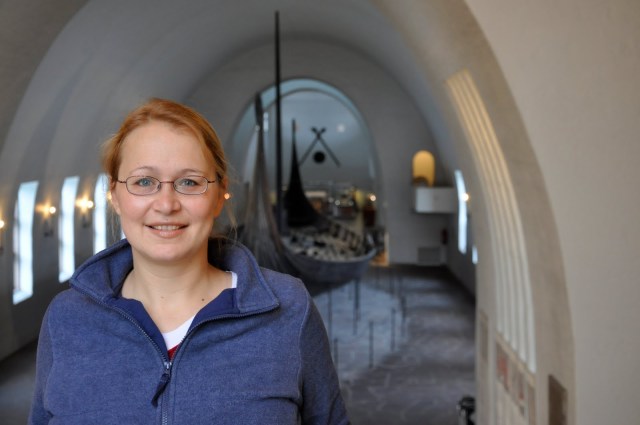
Travel Tuesday: Oslo, Norway
This post about Oslo, Norway originally appeared on my personal blog in 2010. Thanks for asking me to share it again on Travel Tuesday!
I’m glad that when Bruce asked me if I wanted to take a few days on the continent during this trip, I made the executive decision to leave Torran with his parents and give ourselves a holiday within a holiday. Why? you may ask. Oslo was so cold that I got windburned THROUGH my jeans! I would have felt horrible if the wee man had come away with cold related injuries (we left his snow pants at home). Besides, we mostly hung out in museums and shops, not the place for the Tornado.
We flew from Aberdeen to Stavanger with Wideroe on a prop airplane, landing in a very small seaside aiport. The seas must have been churning because the air made it smell more like a fishing harbour than a place of aviation. From there we took an internal SAS flight to Oslo Gardermoen Airport. Getting to the city centre was a breeze with Flytoget train tickets (about $25Cnd, 170 NOK, each way in 2010), a travel time of about 25 minutes. We stayed at the Thon Hotel Opera. Bruce picked it because it was central, and because he gave up on trying to find cheap accomodation in the city centre.
Founded in 1000AD by King Harald Hardråde, Oslo means “the pasture of the gods”, from the Old Norse Aslo (the Norse god “As” and “lo” meaning field). It remained a small city, 3000 inhabitants by 1300, but it’s Norsemen, better known now as Vikings, made their impression upon the world. Through the marriage of the royalty, the Danes ruled Norway beginning in 1380 for 400 years. Oslo was destroyed by fire in 1624, and then rebuilt by King Christian IV of Denmark and renamed Christiania after himself. Norway was ceded to Sweden in 1814 after the Napolenoic wars and remained under Swedish rule until 1905. Although changed to Kristiania in 1877, the original name of Oslo was returned to the city in 1925 by a Norwegian government.
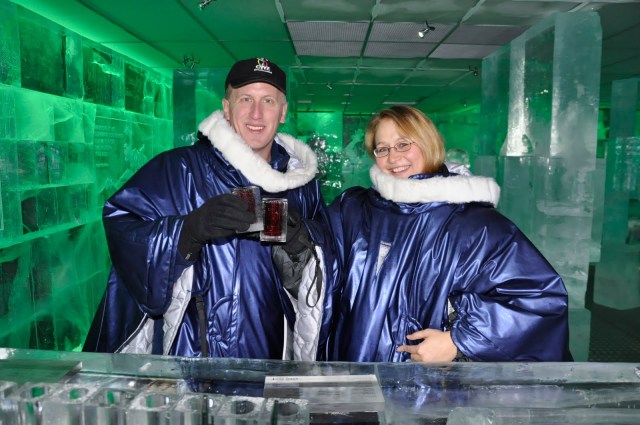
During our first venture into this city, Bruce and I found ourselves in his little piece of heaven. The Swedish ICEHOTEL has created an indoor bar completely made with ice from the Torne River. It gets changed twice a year, and the room is kept at a steamy minus 5 degrees centigrade. The bar’s walls, counter, seating and glasses (everything but the floor and roof) are made of ice, a preview of what once can expect at the ICEHOTEL. Indeed, that is Bruce the human snowman wearing an insulating poncho. We warmed ourselves with yummy cocktails and a warm drink (which was served in a normal cup of course!). Has it changed my mind to spend the night sleeping on a bed of ice and animal furs… um, no.
We roamed the city centre avidly, but were defeated by the cold (unseasonably cold and major wind chills) and the lack of shopping and tourism after 5pm – a result of the country’s comfortable lifestyle and a northerly locale I reckon. The quality of life is high in Oslo, as are the taxes and cost of living. However, its people also seem driven to a good work and study ethic (at least the office block facing our hotel window always seemed to have people working hard).
To improve our explorations, we purchased The Oslo Pass (2010: $55 Cnd each; 340 NOK) for two days and would highly recommend it to anyone touring Oslo. For an affordable price, it gives you access to all the public transportation, free entry to a number of museums, free city parking and discounts at various restaurants and shopping venues. Oslo city centre has a congestion entry charge for vehicles. We ate at Kaffistova two nights in a row, the first time because it has traditional country inspired Norwegian food; the second night because of the discount!
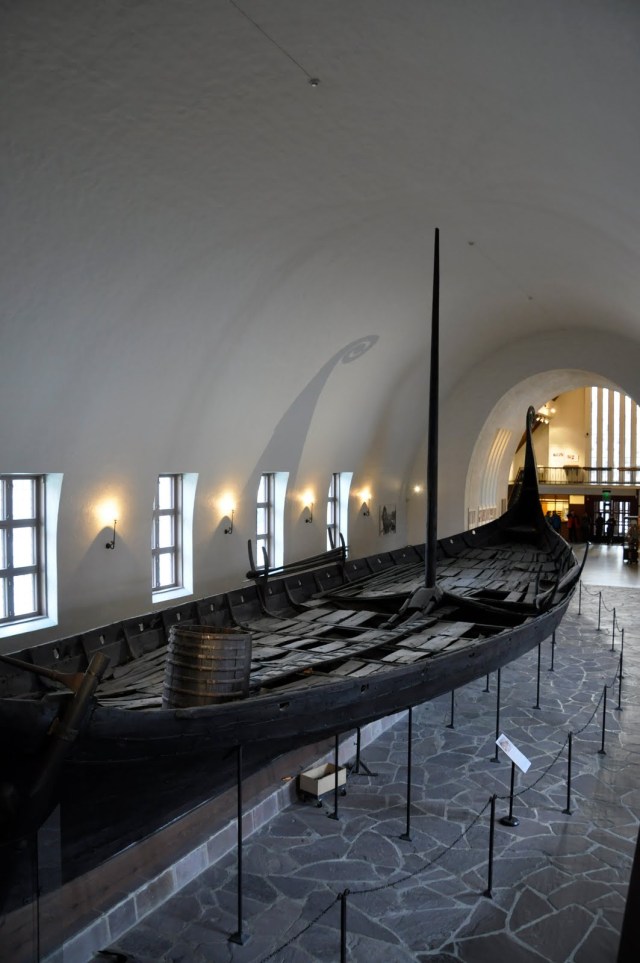
For our first full day out, I chose our The Viking Ship Museum (Wikingerschiffsmuseum) as our beginning destination, even though it’s not my time period of focus in the SCA, I knew one Not So Innocent Viking Chick by Royal Decree who would disown me if I didn’t go… and I’m so very glad that I did. 2010 route: Take bus number 30 to BygdØy (Huk) if the ferry across the bay is closed (off season).
The museum houses the world’s best preserved examples of Viking boats. They were also used as ceremonial burial ships, and were unearthed on the Oseberg, Gokstad and Tune farms in eastern Norway in the late 1800s and early 1900s. As Vikings often cremated their burial ships and contents, finding such intact specimens is what makes them truly remarkable. Mummified bodies and some artifacts were found with the ships, but all metallics had been removed by graverobbers in the middle ages (there were holes found in the ships where someone forced their way inside).

Buried with the noblepersons were objects to help them in the the next life. This includes the only and best known surviving wooden Viking Age wagon in existance, beautified by the detailed carvings on just about all of its non functional surfaces. It was found on the Oseber ship (pictured above; build about 815-820 AD). The Oserberg ship is presumed to be a pleasure craft, requiring 30 men to operate her oars in calm waters. Only two rows of wooden planking would have been above the water line when fully loaded. As a funereal barge it held a prominent female figure (the museum calls her a Queen) who died in 834 AD. The metallic supports underneath the oak planked ship give structure to the ship and prevent further sag of the wooden slats. Ornate Viking carvings adorn both the bow and stern of the vessel.
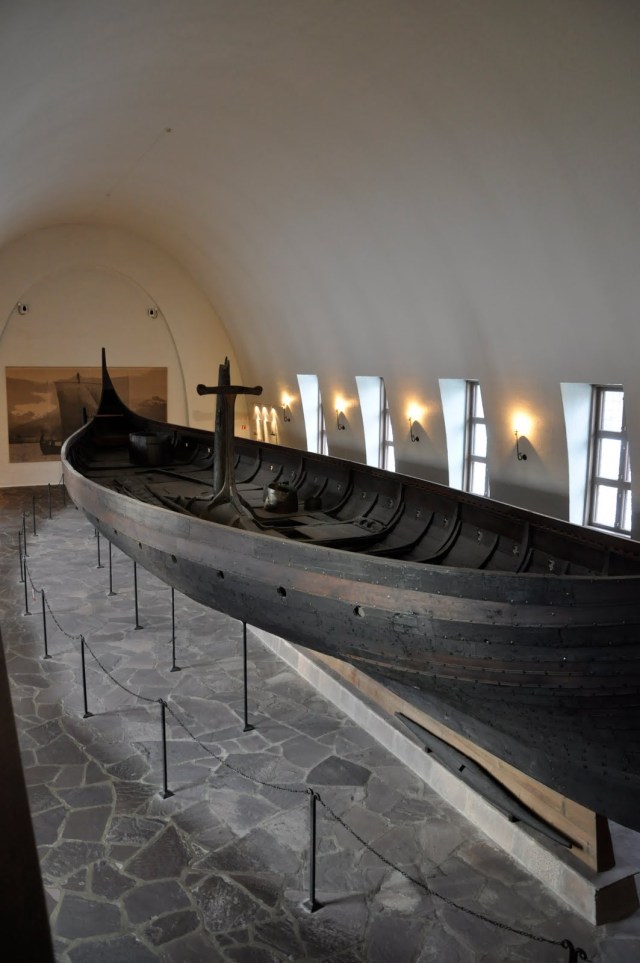
The Gokstad ship (Gokstadskibet), in comparison, has a less shallow and more sturdily built hull (seen here on the left). It was built around 890 AD and had design features which indicate it would have been used as a sailing vessel worthy of the open seas. For example, the oar holes have wooden covers to prevent incoming water. An important chieftain was buried in the ship about 900 AD. The remains of 64 Viking round shields were found during excavation, which would have been mounted on the sides of the ship. Both ships would have used a square sail in good winds, although neither mast survived intact.
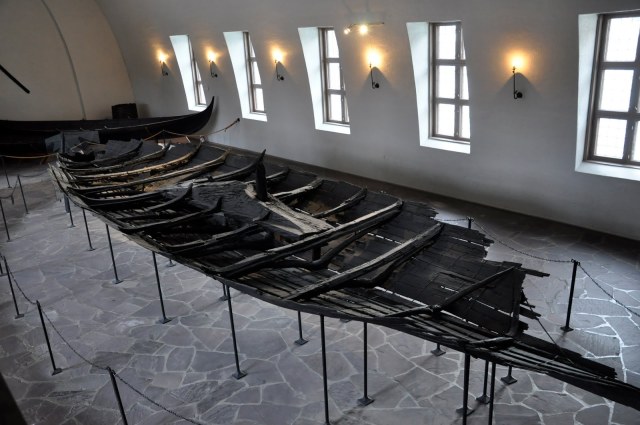
Lastly, the Tune ship originates from circa 900 AD. It remains mostly in ruin (not reconstructed). It also contained a man of high rank, buried in a wooden chamber built on board the ship. However, the grave goods of this ship did not survive to modern day. The museum displays much of what was found on all the ships, as well as some other items from other finds. Some very fragile textiles and weaving cards have also survived for display in the small museum. Interestingly, there is a section which discusses how the remains were re-buried out of respect in the early 1900s, but they (and the fabrics wrapping them) barely survived 80 years in the new burial environment as discovered by researchers who dug up the bodies for DNA identification.
A short (and very cold) walk further along the fjord brings visitors to The Polar Ship Fram (Frammuseet), The Norwegian Maritime Museum (Norsk Sjofartsmuseum) and the Kon-Tiki museum (Kon-Tiki Museet). Alternatively, you can take bus 30B to Bygdoynes. In the opposite direction from the Viking Ship museum (which is also an earlier stop on the bus in this same vicinity), you can find The Norse Folk Museum (Norsk Folkemuseum), an outdoor museum of Norse life from medieval 1500s to modern day in rurual and urban settings. On this trip, outdoor = cold, so I chickened out on that one, as seconded by Bruce who bought himself a knitted Norse headband to keep out the chill, an item he usually only wears when he’s cycling. Another building built literally constructed around a key piece of naval history, the Frammuseet houses the wooden Polar vessel Fram which boldly took stout Norwegian explorers Fridtjof Nansen, Otto Sverdrup and Roald Amundsen farther north and south than any other vessel. We then went to the adjacent Norsk Maritimt Museum and gained a new insight on the nautical history of the Norse people, its shipping and trade.
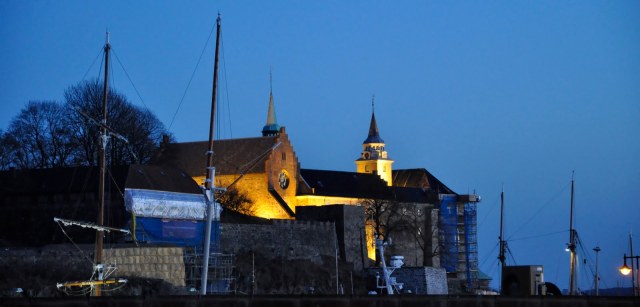
Our day of historical revelations ended with the trail at Akershus Fortress (Akershus Fesning) overlooking the sea. Here too, the weather robbed us of a complete exploration of the site (a 50 minute walking tour outdoors). The castle itself was also closed, perhaps because it’s off season. The building of the medieval castle Akershus started in the late 1200s, mentioned first in 1300AD. Many of the surrounding structres survive from the 1300s, although they have been converted from their original purposes. Later additions were built, of course, to further fortify the castle and its ramparts, the last in 1the 1860s. Part of the Crown Prince’s Bastion (1593-1604 construction phase) was removed to expand the Akershus National Penitentiary in 1860. The Penitentiary was in use during the World Wars, and closed in 1950.

The former Double Battery (1691-16952) is now the home of Norway’s Resistance Museum , a sobering reflection upon the involvement of the people of Norway in World War II. Outside this building 42 patriots were executed for their anti-Nazi beliefs in 1945. It’s a very effective museum, representing the politics and struggles during this insipidous time. Most of the displays are in the local dialect, however, there is enough English to make the venue well worth the trip. There are pieces of history here I never learned about in school, but wish I had. It reminds me how grateful I am that I was born in peaceful time in a democratic and affluent society.
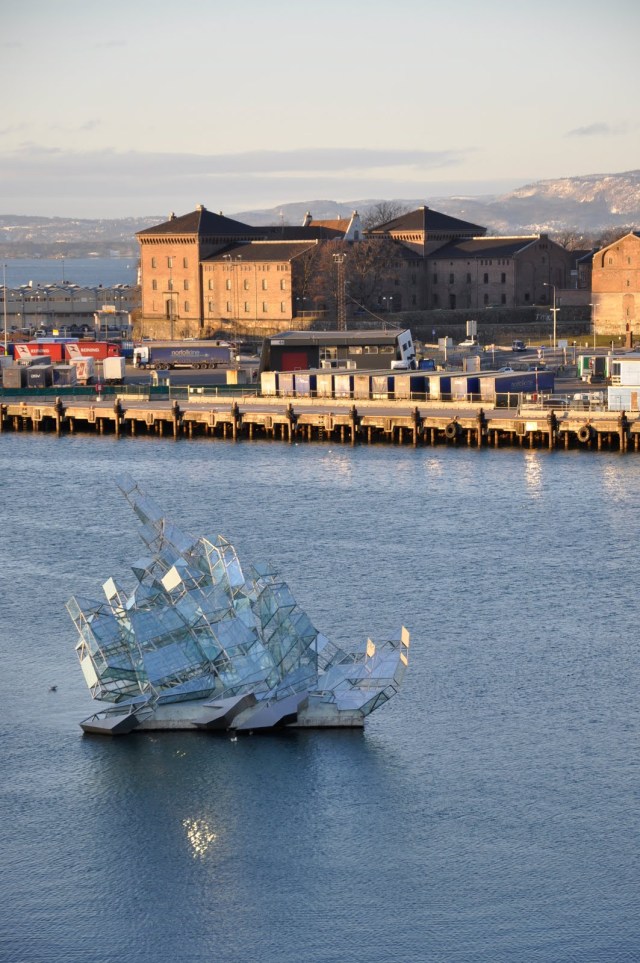
 The following day, we started out with a walk on the roof of the Oslo’s new opera house (Operahusset). An award winning modern structure of italian marble and granite by the firm Snohetta, it appears part glacier as it rises above the water in an area that was previously harbour. The angles of this home to the National Ballet and Opera allow pedestrians to stroll to its peak with ease. Unlike North American buildings, however, there is little to mar the beauty of its design in the way of warning signs, anti-slip strips, handrails or guard rails. Just one little sign advises explorers go up “at your own risk”. Floating in the water is the engimatic She Lies, by Monica Bonvicini, which you can make out to the right of the opera house. It turns on the water in response to the water and wind.
The following day, we started out with a walk on the roof of the Oslo’s new opera house (Operahusset). An award winning modern structure of italian marble and granite by the firm Snohetta, it appears part glacier as it rises above the water in an area that was previously harbour. The angles of this home to the National Ballet and Opera allow pedestrians to stroll to its peak with ease. Unlike North American buildings, however, there is little to mar the beauty of its design in the way of warning signs, anti-slip strips, handrails or guard rails. Just one little sign advises explorers go up “at your own risk”. Floating in the water is the engimatic She Lies, by Monica Bonvicini, which you can make out to the right of the opera house. It turns on the water in response to the water and wind.
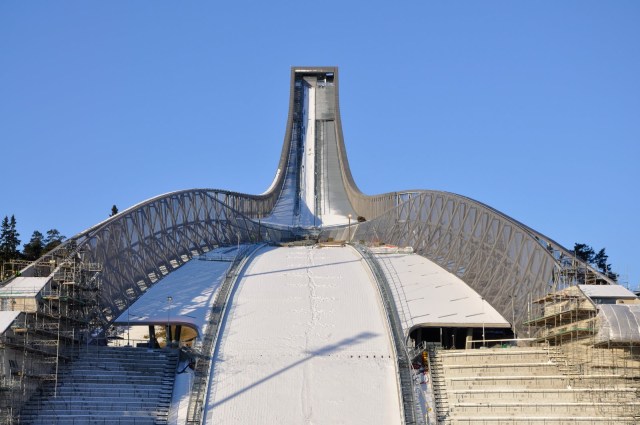
With few short hours of winter time daylight, we sojourned by public transit to the Holmenkollen ski jump, host of the World Ski Championships 2011. We wanted to utilize the day’s short hours and clear skies to capture what our guidebook called “spectacular views” of the city. Instead, we were met with a challenge to figure out how to get there. The subway line, called the T-Bane, to the Holmen-Kollen was being improved for the event and therefore closed. Bruce the uber-navigator found us a shuttle bus from a nearby station on a different line. Once at the top, we forced our way through biting wind to find out that not only was access to the ski jump closed off, but so was the museum and Visitors Centre (which our book said was still open…we hadn’t checked the internet though, yikes!). Needless to say, even Bruce was shivering on the top of the mountain. However, we managed to find a lovely restaurant furnished like a ski chalet and warmed up beside a nice big fireplace. And yes, the views were lovely, albeit not as much as they would have been from the top of the ski jump.
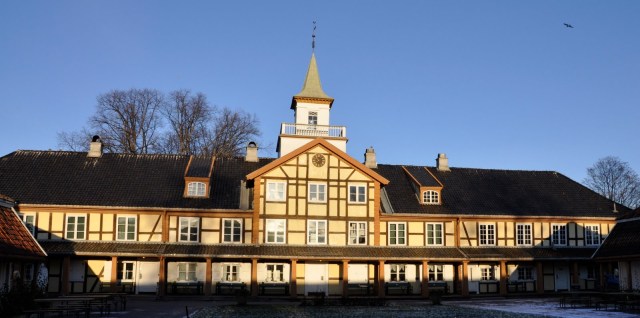
After being stuck in a traffic delay (a pedestrian was struck by a car, and I so wanted to jump out and help – thankfully the Police and Ambulance arrived before my fear of intervening in a foreign country lost its battle), we returned down the hill to the Oslo City Museum (Bymuseet) and the adjacent Vigeland Park (Vigelandsparken). The City Museum has a permanent exhibition of Oslo for 1000 years. It’s medieval portion sadly lacks in content, however. And both Bruce and I were disappointed that the museum seemed to end suddenly, as if they ran out of space. Of note, the picture above of the Frogner Manor House (the entrance to the museum is off this courtyard) was taken at almost 2pm. The sun angle barely rose above 45 degrees during the day.
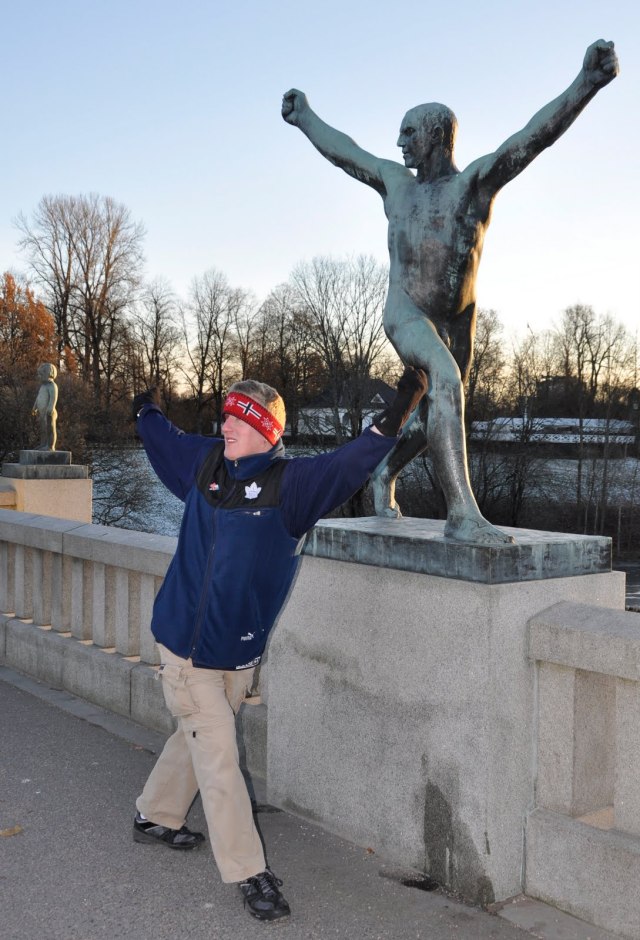
Either I was numb, or distracted, but I didn`t seem to notice the wind so much in the Vigelandsparken. This is one of Norway`s most visited attractions, featuring the life work of celebrated Norwegian sculptor Gustav Vigeland (1863-1943). When Norway gained independence from Sweden in 1905, Vigeland was then showcased as the country`s most important and productive sculptor. More than 200 sculptures adorn a 850 meter long parkade, featuring a bronze fountain representative of the cycle of life, the granite Monolith Plateau, and ending in the sundial The Wheel of Life. At the centre of the plateau rises a 17.3 metre high granite monolith of intertwined bodies – men, women, children in Viegland`s representation of `man`s longing and yearning for the spiritual and devine`. None of the statues have any clothes, though, which may challenge some people`s sense of divinity.
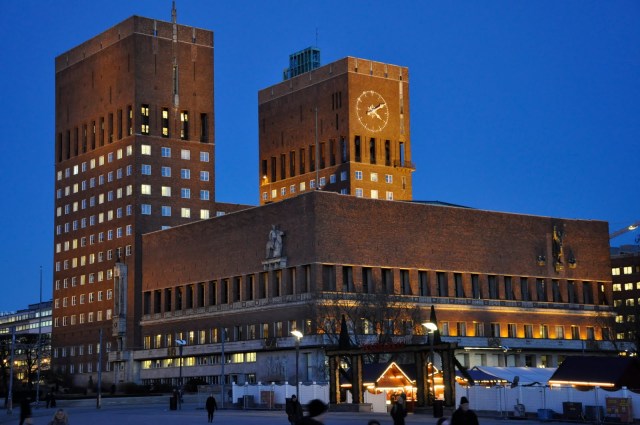
Contempory and contested in its design, the Oslo City hall (Oslo Rådhaus) is the city`s administrative body and council. On December 10th, it is also the venue which hosts the Nobel Peace Prize awards, held in Oslo since 1901. There ia a museum in the building as well, but we I think we missed closing time. There are a multitude of museums in Oslo, we just couldn`t get to all of them in two days!
You may not be able to tell by reading it, but this post has taken me the better part of an afternoon to write (with a break for supper and boy play). Thanks Bruce for taking care of the wee man so I could put it up, otherwise, given the month we have planned, it might not get done!
Before I close off on my pebble of sand in the Norwegian beach, I’ll leave you with one more image, that of the modern take on a Norwegian troll (once the figurative opposite of a giant in Old Norse mythology and now, who knows). Interesting how culture develops in other countries, isn’t it?

